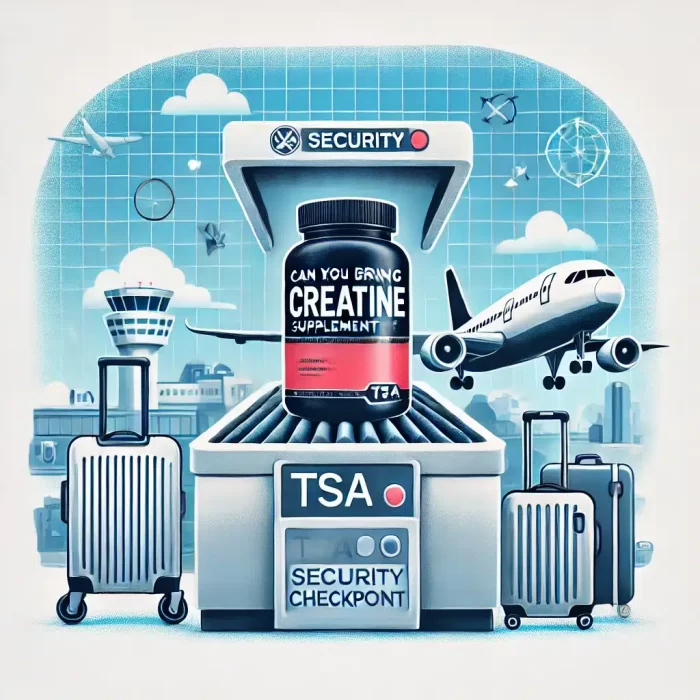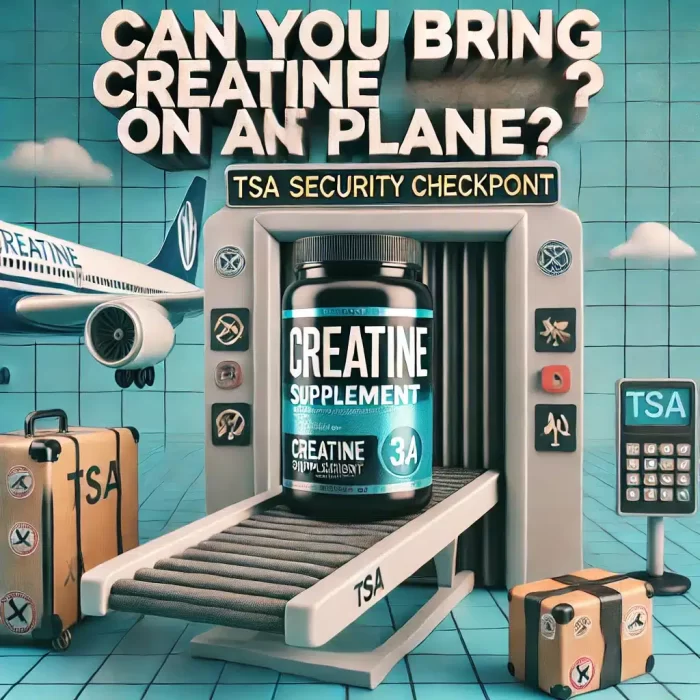Can You Bring Creatine On A Plane?
You’re getting ready for your trip! Got the clothes—check! Got the toothbrush—check! Headphones, passport, and perhaps a new pair of squat shoes for a bit of good luck! Next, you grab your tub of creatine. And all of a sudden, the questions begin to pour in…
“Hey, just checking… is it okay to bring creatine on a plane?” Is this okay? Do you think TSA might find it a bit suspicious? What if they take it away?
Hey there! We’ve all been there, right? Especially if you’ve found yourself in an airport security line, watching someone get pulled aside for packing protein powder in a ziplock bag. It feels a bit uncomfortable. Everyone wants to avoid being that person.
Guess what? There’s some great news! You can take creatine with you on a plane! The TSA isn’t after your gains, but there are a few friendly rules to keep in mind before you toss it into your backpack and head out.
No matter if you’re bringing along creatine powder, capsules, or even a full tub marked like a quirky scientist, this guide is here to help you with all the essentials for a smooth trip and to ensure your creatine stays safe.
Is Creatine Allowed on a Plane?
Yes, creatine is completely legal to bring on an airplane, whether it is in powder, capsule, gummies, or liquid form. There are no specific restrictions on dietary supplements like creatine in either carry-on or checked luggage, and it is not classified as a controlled or hazardous substance. However, how you pack it can impact your experience at security checkpoints, as some forms of creatine, particularly powdered creatine, may be subject to additional screening.
The Transportation Security Administration (TSA) allows powders on planes, but any powder exceeding 12 ounces (350 mL) may need extra inspection. This means that if you are traveling with a large tub of creatine powder, security officers might take a closer look, especially if the container is not labeled clearly. While it is not prohibited, security agents may test the powder to confirm that it is safe. For convenience, many travelers prefer to bring smaller amounts in well-labeled travel containers or stick to capsules instead of powder to avoid potential delays.
For international travel, creatine is generally permitted in most countries, but some nations have stricter regulations regarding dietary supplements. Before flying internationally, it is a good idea to check the specific laws of your destination to ensure creatine is allowed. Some countries may require documentation proving that the supplement is for personal use, so keeping it in its original packaging can be helpful.
Overall, creatine is completely safe and legal to bring on a plane but to avoid any unnecessary security concerns, it is best to store it properly, label it clearly, and be prepared for possible additional screening if carrying larger quantities of powder.
Should You Pack Creatine in a Carry-On or Checked Luggage?
When traveling with creatine, you have two main options: bringing it in your carry-on bag or packing it in checked luggage. Both options are allowed, but each has its advantages and potential drawbacks, depending on how much creatine you plan to bring and how you want to handle security screenings.
Bringing Creatine in Carry-On Luggage
Carrying creatine in your carry-on bag ensures that you have full control over your supplement during travel. Since creatine is not a liquid, it does not need to follow TSA’s 3.4-ounce liquid rule, but if you are carrying more than 12 ounces (350 mL) of powder, TSA may require additional screening. This means your bag might be pulled aside for further inspection, and security officers may swab the container to confirm it is safe.
If you want to avoid extra security delays, consider bringing a smaller quantity of creatine in a well-sealed travel container. Keeping it in its original labeled container is even better, as TSA officers are less likely to question properly labeled dietary supplements. Additionally, powder stored in an unmarked plastic bag may look suspicious, so marking the contents can help prevent misunderstandings.
One of the biggest advantages of packing creatine in a carry-on is that you do not risk losing it. Checked luggage can be delayed or lost, and if your creatine is inside, you may have to go without it for part of your trip. Having your supplements within reach allows you to stick to your routine without interruption.
Packing Creatine in Checked Luggage
If you are bringing a large supply of creatine or do not want to deal with possible security questions, packing it in checked luggage may be the better option. There are no size restrictions on powders in checked bags, so you can pack as much creatine as you need without worrying about TSA screening limits.
However, checked luggage comes with its risks. Bags can be mishandled, delayed, or even lost, meaning you could arrive at your destination without your creatine. If you rely on it for athletic performance or competitions, this can be an inconvenience.
To prevent spills, it is a good idea to double-bag your creatine in ziplock bags or use a tightly sealed container. Checked luggage undergoes rough handling, and if the container opens, the powder could spill inside your bag. For extra protection, storing it inside a sealed plastic container within a ziplock bag is recommended.
Which Option Is Best?
The best option depends on your preferences and travel circumstances. If you are bringing a small amount of creatine and want easy access, carrying it in your carry-on bag is a good choice. If you are traveling with a large quantity and want to avoid security delays, placing it in checked luggage may be more convenient.
For long trips, some travelers choose to bring a small amount in their carry-on while keeping the bulk of their supply in checked luggage as a backup. This ensures they have creatine on hand if their checked bag is delayed while still avoiding excessive powder in their carry-on that could lead to extra screening.
Regardless of which option you choose, packing creatine properly and labeling it clearly will help ensure a smooth travel experience with minimal hassle.
Can You Bring Creatine in Pill or Capsule Form?

Yes, creatine in pill or capsule form is even easier to bring on a plane compared to powdered creatine. TSA does not have any special restrictions on solid supplements like tablets or capsules, meaning they are unlikely to require additional screening. Unlike powders, which may raise concerns at security checkpoints due to their fine texture and resemblance to certain restricted substances, capsules are more easily identifiable as dietary supplements.
One of the biggest advantages of bringing creatine capsules instead of powder is that you avoid the hassle of TSA’s powder rule, which requires additional screening for powders over 12 ounces (350 mL). Since pills and capsules do not fall under this category, they do not need to be removed from your bag during security checks. This makes them a more convenient and hassle-free option for frequent travelers.
To minimize the risk of delays or questions, it is always best to keep creatine capsules in their original packaging. A clearly labeled bottle showing that it is a dietary supplement will help avoid any confusion. If you prefer to use a pill organizer or a travel-friendly container, it is still a good idea to keep at least part of the original bottle or label with you, in case TSA officers or customs agents need clarification.
If you are traveling internationally, some countries have stricter regulations on importing supplements, even in pill form. While creatine is legal in most places, it is always a good idea to check the local laws of your destination to ensure that there are no specific restrictions. Keeping documentation, such as the supplement facts label or a receipt, may help if customs officials ask about the product.
Overall, creatine capsules are the easiest and most travel-friendly way to bring creatine on a plane. If you want to avoid potential security delays, switching to capsules during your trip might be a smart choice.
What About Pre-Mixed Creatine Drinks?
If you prefer pre-mixed creatine drinks or liquid creatine supplements, traveling with them requires following TSA’s liquid restrictions. The 3-1-1 rule states that liquids in carry-on baggage must be in containers of 3.4 ounces (100 mL) or less and placed inside a quart-sized, clear plastic bag. Since most pre-mixed creatine drinks exceed this limit, they cannot be carried in your hand luggage unless they are in small travel-sized bottles.
For those who need to bring larger bottles of pre-mixed creatine, the best option is to pack them in checked luggage. There are no size restrictions for liquids in checked bags, so you can bring full-sized bottles or multiple containers without any issues. However, since checked bags are handled roughly, it is important to pack liquids carefully to avoid spills. Sealing bottles tightly, placing them inside leak-proof plastic bags, or using travel-friendly containers can help prevent messes inside your luggage.
Another option is to purchase pre-mixed creatine at your destination rather than bringing it from home. Many fitness supplement stores, grocery stores, or online delivery services stock liquid creatine, making it easy to buy once you arrive. This is a practical solution if you are traveling for an extended period and do not want to risk spills or baggage weight limits.
For international travel, some countries have specific regulations on liquid supplements, so it is always a good idea to check the customs rules of your destination to avoid any issues at security or customs checkpoints. Some nations may limit the import of liquid supplements or require them to be sealed and clearly labeled.
If carrying pre-mixed creatine is essential, consider transferring it into TSA-approved travel bottles for short trips or simply packing it in your checked luggage for longer stays. If convenience is a priority, switching to creatine powder or capsules while traveling might be the easiest way to avoid restrictions.
Tips to Avoid Problems When Traveling with Creatine
Bringing creatine on a plane is allowed, but following the right packing strategies can help you avoid security delays, spills, or unnecessary questions from TSA agents or customs officials. Proper preparation ensures that you can travel stress-free while keeping your supplement routine uninterrupted.
Keep Creatine in Its Original Container
TSA agents are more likely to recognize creatine as a dietary supplement if it is stored in its original packaging with clear labeling. A sealed container from a reputable brand reduces the chances of extra screening or suspicion. If you need to transfer creatine into a smaller container for convenience, it is best to label it clearly as “Creatine Supplement” to avoid confusion.
Use a Ziplock Bag to Prevent Spills
Creatine powder can be messy if the container opens during travel, so taking precautions can save you from dealing with spilled powder in your bag. Packing your creatine in a sealed ziplock bag or double-bagging ensures that even if the container cracks or leaks, your luggage stays clean. If using a hard plastic container, make sure the lid is tightly secured before packing.
Be Ready for Extra Screening if Carrying Large Amounts
TSA requires extra screening for powders over 12 ounces (350 mL) in carry-on bags. If you are bringing a large tub of creatine, be prepared for TSA agents to inspect or swab the powder to verify that it is safe. To speed up the process, you can place the creatine container in a separate bin at security checkpoints to make screening easier.
Consider Bringing Capsules Instead of Powder
If you want to avoid powder-related security checks, switching to creatine capsules while traveling is a convenient solution. Capsules are not subject to TSA’s powder screening rules, meaning they do not require additional inspection. Since they are easily identifiable as dietary supplements, TSA agents are less likely to ask questions about them.
Check Airline Policies for International Travel
While creatine is legal in most countries, some nations have restrictions on supplements or powders. If you are flying internationally, research your destination’s customs regulations to ensure that creatine is allowed. Some countries may require proof of purchase, original packaging, or documentation stating that the supplement is for personal use. Having this information handy can help avoid delays at customs.
What If TSA or Customs Asks About Your Creatine?
If a TSA officer or customs agent asks about your creatine, it is important to remain calm, polite, and clear about what you are carrying. Creatine is a well-known and widely used dietary supplement, and it is completely legal to bring on a plane. However, because fine powders can resemble other substances on security scans, TSA agents may ask to inspect them more closely.
If your creatine is in its original packaging, the label should make it clear that it is a fitness supplement, which usually resolves any concerns. If you have transferred creatine into a smaller container or bag, it is best to label it as “Creatine Supplement” to prevent confusion. If asked, simply explain that it is a nutritional supplement used for exercise performance and recovery. TSA agents are trained to recognize legitimate supplements, and as long as your creatine is properly stored and within TSA’s guidelines, it will be allowed.
In some cases, TSA officers may conduct an extra screening if you are carrying more than 12 ounces (350 mL) of powder in your carry-on bag. This typically involves a quick swab test to ensure the powder is safe. The process usually takes only a few extra minutes and does not result in confiscation as long as the substance is confirmed to be non-hazardous.
For international travel, customs agents in some countries may have stricter regulations on importing supplements. If asked about your creatine, you can provide a brief explanation that it is a legal, over-the-counter sports supplement. Keeping proof of purchase, a supplement facts label, or a prescription (if applicable) can help clear up any concerns. Some countries may require that supplements be sealed in their original containers, so checking your destination’s regulations ahead of time is recommended.
As long as you pack creatine properly, store it in a labeled container, and follow TSA guidelines, you should not have any issues traveling with it. If asked, a simple explanation that it is a dietary supplement for fitness should be enough to clear up any questions and allow you to continue your trip without trouble.
Final Verdict: Can You Bring Creatine on a Plane?
Yes, creatine is allowed on planes in both carry-on and checked luggage. If you are carrying a small amount, it is best to keep it in its original packaging in your carry-on. For larger amounts, checked luggage is the safest option.
To make your trip smooth:
- Keep creatine in its original container or clearly labeled.
- If carrying over 12 ounces (350 mL), be prepared for extra screening.
- Consider capsules instead of powder for hassle-free travel.
- Pack liquids under 3.4 ounces (100 mL) or place them in checked luggage.
- Check international supplement regulations if traveling abroad.
By following these simple steps, you can travel stress-free with your creatine and stay consistent with your supplementation routine, no matter where you go.






